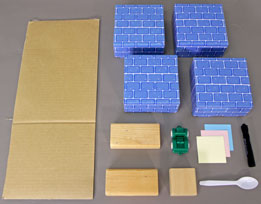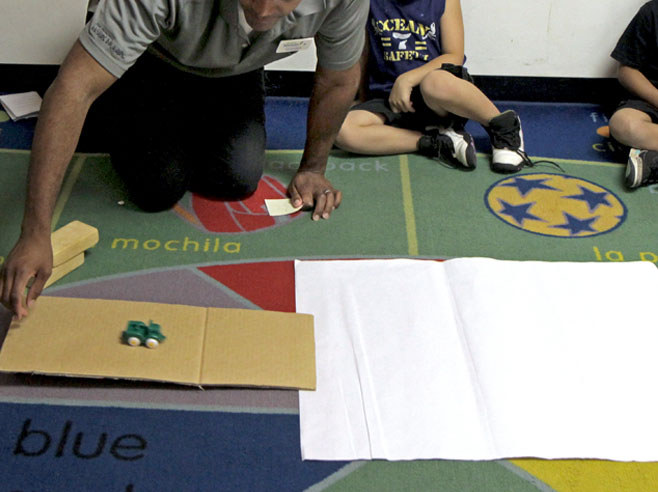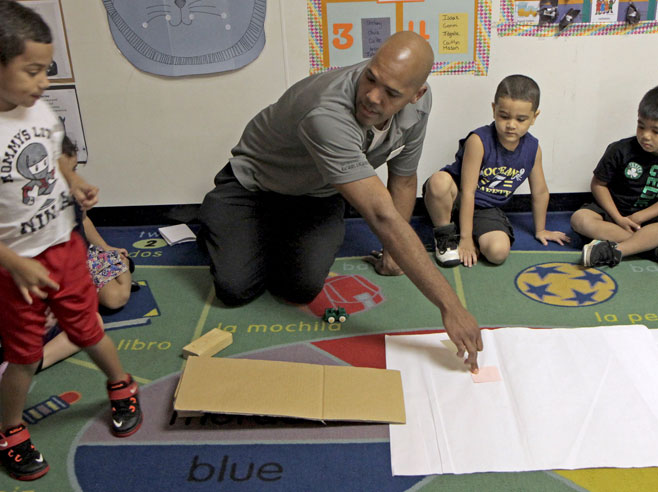The class makes predictions about how far an object will roll or slide each time a ramp gets a little bit steeper or a little less steep.
Materials

- Cardboard ramp (18″–24″ long)
- 4 large cardboard blocks (at least 3” high) to support the ramps for the sliding spoon
- Marker
- Plastic spoon
- Small pads of sticky notes (3 different colors: blue, yellow, pink)
- Tape measure
- Toy car
- 3 wooden blocks to support the ramp for the rolling car
- Optional: Chart paper or poster board (to provide a smooth, even landing at the bottom of the ramp)
Preparation
- Test out the ramp activities for both the rolling car and the sliding spoon. Decide whether to provide chart paper/poster board to create a smoother ramp landing area.
- Make sure there is sufficient landing space for the car when it comes off the ramp supported by four wooden blocks.
- Test out the sliding activity in Part 2, so that you know how far a plastic spoon will slide when it goes down a ramp supported by four cardboard blocks (12″ high), three blocks (9″ high), and two blocks (6″ high).
- Draw a star on a (yellow) and a (blue) sticky note.
Directions: Lesson 4
Circle Time: Introduction
- Part 1: Rolling Down a Ramp. Have a child demonstrate how to build a ramp using one WOODEN block.
- If you are using a sheet of chart paper or poster board to provide a smoother landing, place it in front of the ramp.
- Ask children if they would describe this ramp as a steep ramp or a gentle ramp. Use your arm to show a steep and a gentle incline, to clarify the words.
- Tell children that you are going to do an experiment to see how far a toy car will travel when it rolls down this gentle ramp.
- Have them count, “1, 2, 3 . . . Go!” Release the car. Observe how far it rolls.
- Have a child help you mark with a small (pink) sticky note the spot where the car stopped. Measure how far the car rolled. Model for children how to align the measurement tool from the bottom edge of the ramp to where the sticky note is placed.
- Ask children to observe as you add one more wooden block to the ramp support. Possible discussion ideas:
- How did adding another block change the ramp? Did it make the ramp steeper or less steep?
- Ask children to predict how far the car will go when it is sent down the steeper ramp. Do you predict that the car will travel farther or less far than it did on the first ramp? Why do you think that?
- Encourage children to listen to and build on their classmates’ responses. Use prompts such as: Do you agree with (child’s name)’s prediction? Why do you think the car will go farther?
- Help children place a (yellow) sticky note to indicate how far they predict the car will roll when it comes down the steeper ramp.
- Have children count, “1, 2, 3 . . . Go!” and release the car. Observe how far the car rolls. Use the tape measure to measure how far the car rolled. Was our prediction correct?
- Add a third wooden block to the ramp support to make a steeper ramp.
- Have children describe how the ramp has changed, make a new prediction, and repeat the experiment.
- Now have a child help you build an even steeper ramp, using the piece of cardboard and four CARDBOARD blocks (total height is 12″).
- Ask children if they would describe this ramp as a steep ramp or a gentle ramp.
- Repeat the previous prediction (using a (blue) sticky note), experiment, and observation with this steepest ramp.
- Part 2: Sliding Down a Ramp. Remind children that because the toy car had round wheels, it rolled down the ramp.
- Hold up the plastic spoon and ask, How do you think this spoon will move when I put it on the ramp? Do you predict it will roll or slide? Why do you think that?
- Use the ramp from Step 4. Release the spoon and let it slide down the ramp. Have a child help you mark with a small (pink) sticky note the spot where the spoon stops. Use the tape measure to measure how far the spoon slid.
- Place a (yellow) sticky note with a star at a distance from the ramp where a spoon will stop after sliding down a ramp supported by just three cardboard blocks (one block less than there is now). Note: It will be closer to the ramp than the (pink) sticky note. Possible discussion ideas:
- How can we make the spoon slide less far and stop on this star? Do you predict that we should make the ramp steeper or less steep? Add or take away a block? Why do you think that? Encourage children to voice their opinions and state their reasons.
- When the majority of children agree, remove one block from the ramp support. What did I just do? How did taking one block away change the ramp? Did it make the ramp steeper or less steep?
- Experiment! Send the plastic spoon down the new, gentler ramp. It should stop near the (yellow) sticky note with a star. Use the tape measure to measure how far the spoon slid.
- Have children make another prediction. Place a (blue) sticky note with a star at a distance from the ramp where you know a spoon will stop after sliding down a ramp supported by just two cardboard blocks (one block less). Note: It will be closer to the ramp than the (yellow) sticky note. Possible discussion ideas:
- How can we make the spoon slide less far and stop on this star? Should we make the ramp steeper or less steep? Ask a child to make the ramp a little less steep. (The child should remove one block.)
- Experiment! Send the plastic spoon down the gentler ramp. It should stop near the (blue) sticky note.


